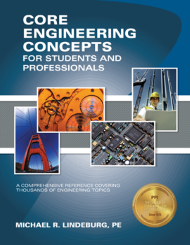Core Engineering Concepts for Students and Professionals (Print)
Find the answers to your engineering questions with Core Engineering Concepts for Students and Professionals. This authoritative reference provides comprehensive coverage of thousands of engineering concepts in one convenient book, including topics covered in 4- and 5-year engineering degree programs and those encountered in practice.
This book is a cross-disciplinary reference that can be used by engineers studying or practicing in any engineering field, including civil, mechanical, electrical, structural, environmental, industrial, and chemical engineering. Written for both students and practitioners by a professional engineer, it incorporates more than 30 years of engineering experience.
- Covers the breadth of an engineering degree
- Contains civil, mechanical, electrical, chemical, and industrial engineering subjects
- Features 82 chapters covering thousands of engineering concepts
- Contains more than 580 example problems with step-by-step solutions
- References over 3,700 essential engineering equations and formulas
- Presents over 315 figures and 780 tables
- Lists fully defined nomenclature for each chapter
- Includes a multiply cross-referenced index
- Atomic Theory
- Biology
- Chemistry
- Computer Programming
- Dynamics
- Electrical Circuits
- Engineering Licensure
- Ethics and Law
- Fluids
- Heat Transfer
- Management Science
- Material Science
- Mathematics
- Mechanics of Materials
- Plans and Drawings
- Physics
- Statics
- Systems Analysis
- Thermodynamics
FAQs
The FE CBT exam is closed-book aside from the NCEES FE Reference Handbook which is provided to you on-screen during the exam. You cannot bring any outside resources into the exam. Because of this, it is imperative that you familiarize yourself with the NCEES handbook before exam day.
PPI’s Learning Hub allows you to upload your own copy of the NCEES Handbook PDF when you take quizzes and practice exams on the left of the screen to mimic what it will look like on exam day.
The exam is made up of multiple choice questions, as well as AIT’s, or alternative item types. AIT’s can include but are not limited to: multiple correct, point and click, drag and drop, and fill in the blank.
